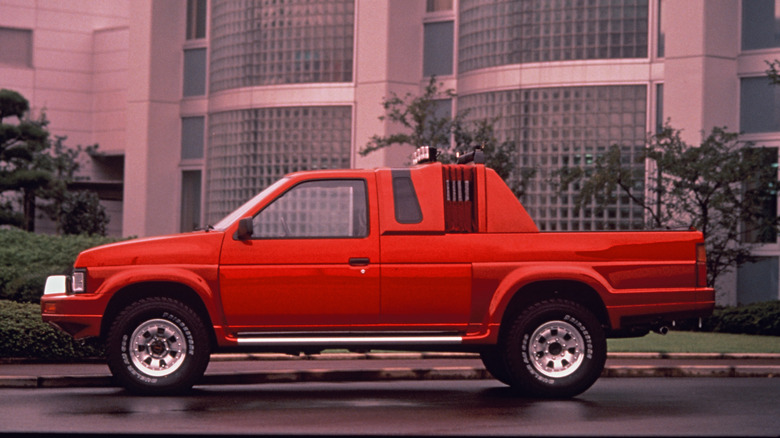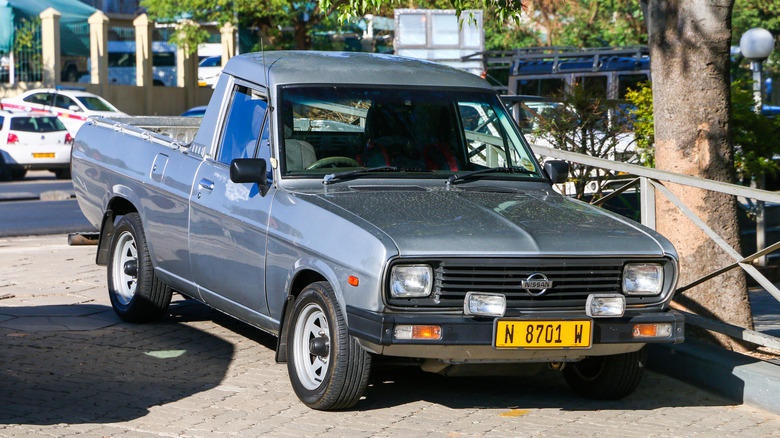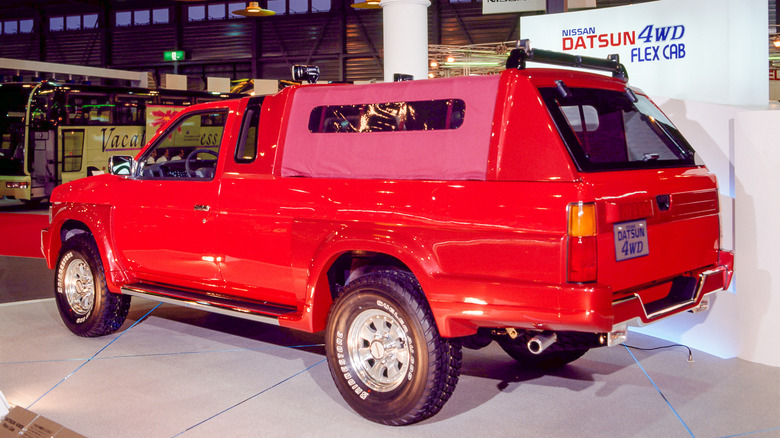This Strange Nissan Concept Had An Innovative Feature We'd Love To See On A New Truck
The truck is having a bit of a moment. Electrification has brought a full dose of new utility features from trucks by stalwarts like Ford and Ram and startups like Rivian.
From Ford's Mega Power Frunk that doubles as a massive ice bucket to slide-out camping kitchens from Rivian and the ability to power anything from televisions to your entire house, these trucks are pretty smart — but they all lack the ability to transform from an open-bed truck to an enclosed SUV.
This is where a genius concept idea from Nissan comes in. Revealed back in 1991, Nissan came up with a design for a truck with an adjustable cab that could be made larger or smaller. It was called the Nissan Datsun 4wd Flex Cab, and although there's no denying it looks like an accordion, it could have been revolutionary.
And don't forget; this was back when the SUV as we know it today had yet to arrive. There were 4x4s and off-roaders like the Land Rover Defender and Mitsubishi Shogun, and then there were conventional trucks like the Ford F-150, but nothing in-between. What Nissan had was a vehicle that could have satisfied the buyers of both.
What is a Datsun, anyway?
Originally Datson (with an 'o'), Datsun became the name used by Nissan for all vehicles exported from Japan between 1958 and 1986. Before we had Nissans in the US, UK, and Europe, they were known instead as Datsuns. The brand was temporarily retired in 1986 when Nissan instead opted to use its own name across all markets.
Meanwhile, the Datsun Truck was born in 1934 and revived after World War II in 1946. The truck was continually upgraded through the next two decades, including Nissan's overseas expansion with the Datsun brand. The Japanese company switched from Datsun to Nissan in the US for the 1985 model year, but it combined the names into Nissan Datsun for its trucks.
By now, Nissan was selling the D21 truck (known as the Hardbody in the US), and it is this vehicle on which the Flex Cab was based. An interesting option in the US market was the King Cab, which was priced at $15,792 (undercutting Ford by $1,000) and included a pair of fold-down seats facing each other in the back of the cab.
Nissan had a truck with a regular single cab and the larger King Cab, but what about something that could offer both layouts? This is where the Flex Cab comes in, based on the D21 and revealed as a concept in 1991.
Utility ahead of its time
Here was a truck with a regular single cab plus a full-height cover that could be extended to cover the bed. The cover used standard body panels at the front and back, complete with an opening rear window, but between these was a foldable canvas section with equally flexible plastic windows. The idea was that the rear could slide back and forth, revealing a conventional open bed or covering it entirely, creating a secure, enclosed space behind the cab.
Very little is known about the Flex Cab — other than it didn't make it to production — and it isn't clear whether the extended cab could house extra seats or if it only created a covered storage space. The former has practical uses; even the latter would help keep the bed and its contents dry and secure.
Today we have trucks with lockable bed covers, but these tend not to add height to the stowage area. Nissan's design provides an enormous, full-height space for transporting large items, or you could even fit a mattress in there and go camping in relative luxury; no need to pitch a tent; extend the Flex Cab and settle down for the night. Imagine if this concept came back with today's more refined manufacturing processes. We could see it appearing on the back of a next-generation electric truck from Rivian.


